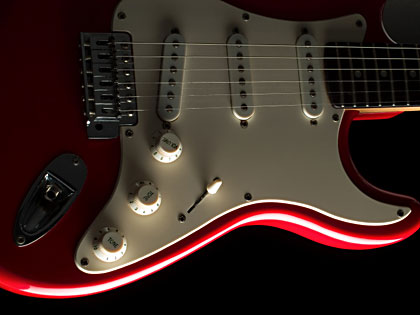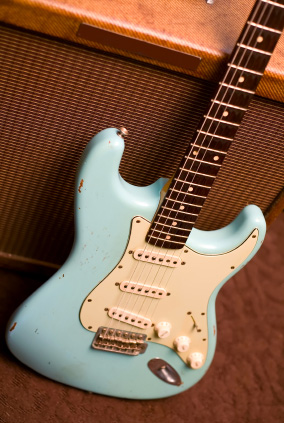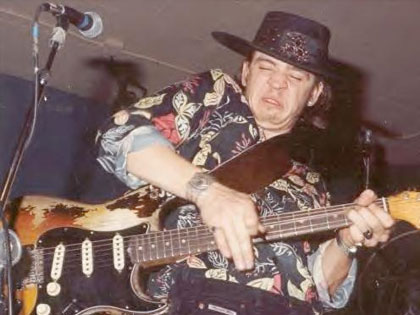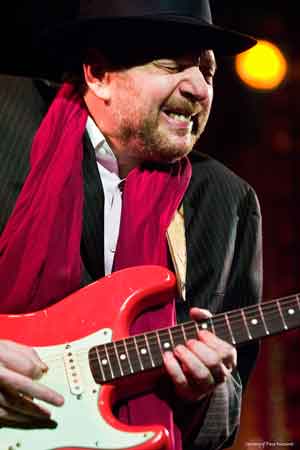 Clearly one of the most used guitars in all of the blues, the Fender Stratocaster is found everywhere. Eric Clapton, Jimi Hendrix, Stevie Ray Vaughan, Ronnie Earl, Bonnie Raitt and Buddy Guy not only play Stratocasters but are literally defined by their use of them. Plenty of other blues guitarists use it too as part of their guitar arsenal.
Clearly one of the most used guitars in all of the blues, the Fender Stratocaster is found everywhere. Eric Clapton, Jimi Hendrix, Stevie Ray Vaughan, Ronnie Earl, Bonnie Raitt and Buddy Guy not only play Stratocasters but are literally defined by their use of them. Plenty of other blues guitarists use it too as part of their guitar arsenal.
The Strat was created by Leo Fender in 1954. It’s design was the result of constant research and improvement to his entire line of solid body electric guitars which started with the Broadcaster in 1950. Actually the Broadcaster was preceded by the Esquire and eventually became the Telecaster due to the fact that the name was already trademarked by Gretch.
The Broadcaster was the first solid body electric guitar (even before the Gibson Les Paul) and was an immediate hit with professional guitarists. Most electrics of the time were hollow-body and constantly battled feedback at high volumes. A solid body was less prone to feedback.
The Telecaster had a unique sound that fit well with country and blues bands of the day. B.B. King is seen playing one in an early photograph. I hope Lucille will understand and not be jealous.
But in his never-ending goal of improving his guitar designs, Leo Fender developed the Stratocaster and it had some clear improvements over the Telecaster design.
- It had better intonation. Each string was individually adjustable.
- It had better tone options. It had 3 pickups instead of 2.
- It was easier to hold due to it’s scolloped rear side
- It had a vibrato bar (whammy bar)
The Stratocaster had design features that were way ahead of its time. And it actually sold poorly in its first few years. By the 1960’s that was old news and The Strat was the dominate guitar, along with the Les Paul.
First Blues Guitarist To Use Stratocasters
Pee Wee Crayton was the first to use a Stratocaster in 1954. His “The Telephone Is Ringing” may be the first recorded version of the Strat on vinyl. Soon Buddy Guy and Otis Rush were using it and the Stratocaster was off playing the blues. Buddy Guy can be seen using a Strat in the early 60’s on the videos of the American Folk Blues Festival in Europe.
Ike Turner played a Strat too. If you don’t know Ike, he was an American guitarist, musician, songwriter and record producer known for his work with the Ike & Tina Turner Revue and the Kings of Rhythm. He recorded what many say was the first rock and roll song, “Rocket 88” at Sun Studios in 1951. But he also played a lot of blues in his day.
Turner was an early adopter of the Stratocaster, buying one on its release in 1954. Unaware that the guitar’s tremolo arm could be used to subtle effect, Turner used it to play screaming, swooping and diving solos. Turner explained his technique by saying:
“I thought it was to make the guitar scream—people got so excited when I used that thing.”
Also on the rock side, Gene Vincent was a big endorser and his band the Blue Caps all played blonde versions of the instrument (and a blonde Fender Precision bass as well). And of course Buddy Holly may have been the first major proponent of the Stratocaster and it defined his sound in many was. That sound would become the basis for many rock records over the years.
The Stratocaster in the 60’s

By the time the 60’s came around the Stratocaster was everywhere. It had been a major instrument in 50’s rock and roll but when the psychedelic 60’s arrived, and Jimi Hendrix became popular, it began to take over.
Not that Gibson was lying down on the job. The Les Paul was also hugely popular, and England’s best blues band, Fleetwood Mac, featured Les Pauls. Peter Green of Fleetwood Mac would become one of the leading purveyors of that great Les Paul sound. And of course B.B. King was committed to his Gibson 335s and 345s by this time, so clearly Gibson played an important role in the blues as well.
But the Strat had it’s converts too. Eric Clapton had long been a Gibson player in his early blues days with John Mayall and with Cream, but around 1968 he was ready for a change. Long, drawn out leads were becoming passe and Clapton wanted to separate himself from those days and that sound, so he started using a Tele in Blind Faith and later with Delaney and Bonnie fully made the switch to Stratocaters. Here’s what he said about the change…
“I bought a beautiful old strat in ’67 when I was in Cream and it was just right for the bag I was playing with Delaney and Bonnie”… “I had a lot of influences when I took up the Strat. First there was Buddy Holly, and Buddy Guy. Hank Marvin was the first well known person over here in England who was using one, but that wasn’t really my kind of music. Steve Winwood had so much credibility, and when he started playing one, I thought, oh, if he can do it, I can do it.”
Eric has been playing Stratocasters ever since and now it’s hard to think of him without it. Who knows how many guitar purchase choices have been influenced by his use of the Strat.
Between Clapton, Hendrix, and maybe Robbie Robinson of The Band, the Stratocaster had clearly been established as the standard for that blues, roots rock, and country rock sound during the 1960’s.
The Stratocaster in the 70’s
The 70’s were a time of experimentation for guitarists. Music was becoming more sophisticated and the evolution of the guitar sound was too. As jazz rock and it’s new form that was called “fusion” was becoming more popular, the blues and basic rock and roll took a back seat. Still the Stratocaster went along for the ride on this new jazz/rock style. Jeff Beck’s albums like “Blow by Blow” and “Wired” featured him using the Strat more and more. Today Jeff Beck is identified with the Stratocaster and his use of the Vibrato bar is an integral part of his sound and style.
Still the Strat was there for funk and soul music and Clapton continued to feature the Strat through the decade that would define him as a major song writer as well as guitarist.
And the blues was still going on in the 70’s but it was found more in the rock bands of the day that really created the Blues Rock sound. ZZ Top, Free, Savoy Brown, The Allman Brothers, Led Zeppelin, Johnny Winter, and even AC/DC carried the torch of the blues through the decade. Yes it sounded different but no one can argue the influence. Even most of the guitar players in those bands would agree that they were heavily influenced by the blues that came before.
But yes, the Stratocaster was taking a back seat to this heavier, more distorted style of blues. That is until the Texas sound took over in the 1980’s.
 The Stratocaster in the 80’s
The Stratocaster in the 80’s
The Blues in the 80’s started out with the seminal movie “The Blues Brothers.” That movie would do more to bring back The Blues and it’s history than just about anything that happened in blues the previous decade.
It all started from a 1976 sketch on Saturday Night Live that featured John Belushi and Dan Aykroyd dressed up as killer bees and singing the old Slim Harpo tune “I’m A King Bee”. It soon turned into a full-fledged “schtick” with Belushi and Aykroyd playing the parts of Jake and Elwood Blues, a brother act that played Chicago Blues and soul. The bit turned into a movie and a whole new generation was turned on to rhythm and blues again. Call it the next wave.
Stevie Ray Vaughan
But the big jump in blues popularity came in 1983 when Stevie Ray Vaughan burst on the scene. His high-energy Texas blues style was a perfect way to take the blues rock lovers of the 70’s back to a more authentic blues style. That Texas Blues style had been there all along with the likes of Freddie King and Johnny Winter but the style was spearheaded by Vaughan’s older brother Jimmy in his band The Fabulous Thunderbirds. Stevie just took it to a new level.
And of course Stevie Ray Vaughan’s sound is all about the Stratocaster. His use of it really spawned a rebirth of the Strat in the blues. And countless numbers of new guitar players picked up a Strat to try and sound like Stevie. The Blues would never be the same again.
And it was clear that Stevie Ray Vaughan’s style was based on blues guitarists that came before. Apart from the Jimi Hendrix side of Vaughan, the Albert King and Albert Collins influences are clearly there. Lonnie Mack was also an influence. And the fact that he often played with his heros only help their stature and bring them back to the forefront of blues.
And for me, each time I’m reminded of how great the early blues guitarist were, the more I get inspired to get better. It’s funny, when I listen to Stevie Ray now, I realize his main contribution was not his playing or guitar skills, it’s the fact that he made us all look harder at the players that were really great like Albert King, B.B. King, and Freddie King. These were his major influences and you can hear each in his playing.
In the 80’s the popularity of the blues was at a peak. Stevie Ray and The Blues Brothers spawned many new fans and bands. Great young white guitarists and blues bands emerged including The Fabulous Thunderbirds, Anson Funderburgh and The Rockets, James Harmon, Ronnie Earl, and Rod Piazza and the Mighty Flyers. Roomful of Blues is one of my favorite bands and their history goes back to the early 70’s. Both Ronnie Earl and Duke Robillard came from that group.
 The Stratocaster in the 90’s and beyond
The Stratocaster in the 90’s and beyond
Much of what happened to blues in the 80’s just continued into the 90’s. Blues was still popular and that popularity led to many new bands and a bunch of new “Blues Societies” developing throughout the United States and Europe. This kept the blues growing and it was a great time to be a blues guitarist. The Stratocaster remained popular and was probably the guitar of choice, still thanks to Stevie Ray Vaughan’s influence (even though he died in 1990).
And Eric Clapton went back to the blues and recorded a great traditional blues album that featured authentic arrangements of blues classics. From The Cradle, from 1994, was part of every blues fan’s record collection in the 90’s. He shows great respect and understanding for traditional blues styles on that album and his versions of Muddy Waters, Lowell Fulsom, and Elmore James songs. Of course the Stratocaster is featured throughout the album.
Swing and jump blues music made a big comeback in the late 90’s. Several movies and albums helped make this happen. Of course, Cab Callaway’s presence in The Blues Brothers movie helped plant a seed for swing, but it was movies like “A League of their Own“, “The Mask” and “Swing Kids” that helped bring the style, and the dancing, to the forefront. It spawned a flood of new bands based on the style including Big Bad Voodoo Daddy, Cherry Poppin Daddies, and Brian Setzer Orchestra. Of course it didn’t hurt many of the originators including the big bands and Louis Jordan, Louis Prima, and Cab Callaway.
This rebirth meant less for the Stratocaster than it did for the overall popularity of the blues. Authentic guitarists of that style tended to use hollow-bodied guitars for swing but that didn’t keep Ronnie Earl or Chris Vachon of Roomful of Blues from using a Strat for their jump swing style..
So today the Stratocaster is firmly entrenced in the blues. It’s still the most widely used of guitars for the blues, and as you know it’s my personal favorite. You can’t go wrong with a Strat.
And blues is still alive and well if a bit less popular in the mainstream. But as we all know it will be back for the next wave. It’s just a matter of keeping it alive till the next generation notices it again. And I’m sure the Stratocaster will be there all along.
Stratocaster Buying Guide
Our friends at Musician’s Friend has graciously created a Stratocaster Buying Guide if you are trying to figure out all the nuances of Strats. I learned some things myself, like the main difference between vintage and modern Strats is the fretboard radius. Vintage are 7-1/4” fretboard radius and modern are 9-1/2”. That’s one reason I love vintage Strats. Who knew?


